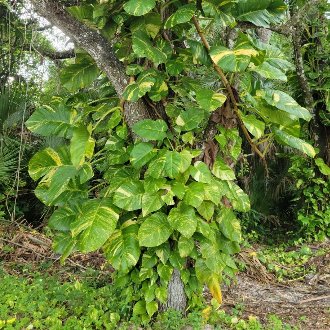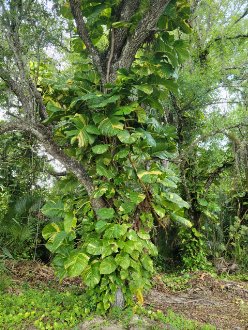Golden Pothos (Epipremnum aureum (Linden & André) G.S.Bunting)
Also known as Ceylon creeper, hunter's robe, ivy arum, silver vine, Solomon Islands ivy, taro vine, devil's vine, devil's ivy; also classified as Pothos aureus Linden & André, Rhaphidophora aurea (Linden & André) Birdsey, Scindapsus aureus (Linden & André) Engl.
↑Range - Expand
| Legend | Color |
| Introduced |
This map is based on our research. We have checked its accuracy to Level 3 ecoregions. Although this plant occurs somewhere in each of these regions, it may only occur in a small part of some or all of them.
This species is native to the Society Islands. POWO shows it as established in Florida, but neither BONAP nor FSUS list it. However we found numerous county records in the Atlas of Florida Plants, which emphatically notes that their map is based on vouchered plant specimens from wild populations and that cultivated records are excluded. Our map is based on their reports.
↑Uses
This species is widely grown as a houseplant, where it is valued for being tolerant of a wide range of lighting conditions, from extensive direct sunlight to no direct sun at all; it can grow in low light levels such as a room with only artificial light and no special grow bulbs. It is also tolerant of flooding and can be grown in standing water, but established plants have significant drought tolerance as well.
These same qualities give this species invasive potential, in areas mild enough for it to survive. It is not cold-tolerant and can be easily killed by frost.
We recommend caution with this plant in areas warm enough for it to survive, and particularly recommend against growing it outdoors in these areas.
↑Related Plants
This species is closely-related to the centipede tongavine (Epipremnum pinnatum), which has also been introduced to North America. More broadly, it belongs to the Monsteroideae subfamily of the Araceae family. This subfamily consists mostly of tropical plants, none of which are native to North America, but many are grown as houseplants. One of the more commonly grown such plants, which has also established in the wild in Florida, is swiss cheese plant (Monstera deliciosa). The broader Araceae family contains many more plants, both native and introduced.
↑Notes
We recommend against the common name "taro vine" to refer to this species for several reasons. It is ambiguous, also used to refer to other related plants including the centipede tongavine (Epipremnum pinnatum) and swiss cheese plant (Monstera deliciosa), and it is also somewhat misleading as this species is not a true taro (Alocasia sp.) and is not even within the same tribe or subfamily, although it does belong to the same family, Araceae.
↑Links & External Resources
• golden pothos | Missouri Botanical Garden Plant Finder (About This Site)
• Epipremnum aureum (Linden & André) G.S.Bunting | Plants of the World Online (POWO) (About This Site)




